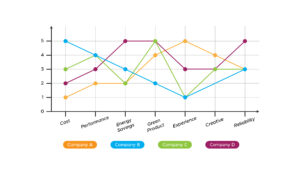One of the first exercises I run new clients through is testing whether they know what their white space is and how to leverage it to create a marketing strategy.
What Is White Space?
In marketing, white space is a term describing where your brand (not your technology) has an unfair advantage over its competitors.
White space isn’t just being the best of the best in your category. You want to redefine the category so the perception is that your brand is the only option for customers looking for a specific solution.
This concept trips up many cleantech companies because they are trained to compete solely on performance metrics, when in fact those metrics are simply table stakes that get you in the door but don’t close a sale.
Here’s how this outdated and flawed assumption works in the B2B space in cleantech.
We’ve created the world’s best widget > You will buy our widget because it performs better than the old widget and saves you money.
There are numerous flaws in basing your cleantech brand marketing strategy on this assumption, not the least of which is it goes against the grain of how neuroscientists have demonstrated the decision-making process in the human brain.
Why Is White Space Key To Your Long Term Success?
Every market ebbs and flows and technology improvements in the cleantech space are especially rapid.
White space is core to your marketing strategy because your brand needs to stand on something beyond who has the best technology at a given moment in time. In fact, the phrase, white space underlies the concept of “cornering the market.”
Your brand shouldn’t try to appeal across the board, just to those who are looking to solve a specific problem. Finding your white space should lead that market directly to your brand as the obvious and only choice for them–whether or not your technology is the top performer in its category.
Once you’ve identified your white space, it should become the focal point for all your digital and non-digital communications because that’s what you want to reinforce. The result should be more targeted leads and a higher sales closing rate.
How To Identify Where You Have An Unassailable Advantage In Your Industry.
In the interview process, I ask clients and customers to define a value curve, that is, what are the key factors on which their industry competes.
Then I ask what perceptions my client owns and which perception their various competitors own.
When we finish, there’s a chart that will look something like this:

As you can see, along the bottom the key factors are listed, and along the left are the ratings. If the participants in the interviews were able to set aside their own biases, there should be one or two factors where your brand places higher than all of your competitors.
Does White Space Matter For Cleantech Companies?
Investment in cleantech runs like a herd. In the last year, financing has been pouring in for industries like fusion energy, green hydrogen, direct air capture, carbon capture and use, and green cement industries–and every one of those industries has multiple startups trying to break from the pack.
Some of the smart money might head towards performance, but an exponentially larger share will go to those companies with a compelling back story and an understanding of where their strengths match up well with a niche market.
Only Half Of Your Marketing Strategy Is Finding Your White Space.
It’s not enough to just identify your white space; you need to find ways to leverage it with an audience who cares. Think of it like a key and a keyhole. As good as each may be, they can only be successful when put together.

A shocking number of cleantech startups end up changing market direction specifically because they didn’t perform the necessary market research to figure out if the audience laid out in their initial business plan would care enough to change their status quo to adopt new technology.
If there’s a misalignment between the white space and your audience, it’s far more efficient to rethink your marketing strategy at the outset than it is to change the mindset of your audience.

